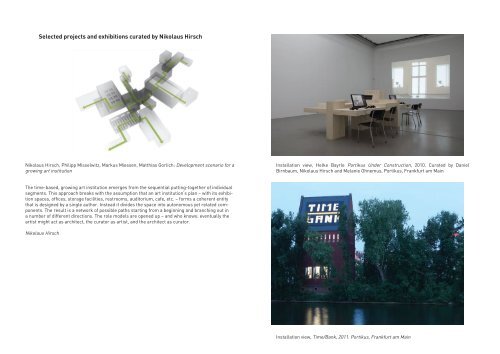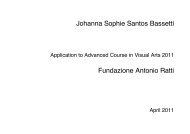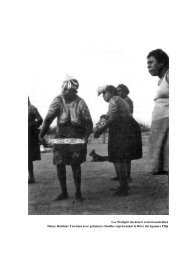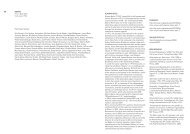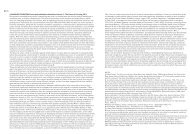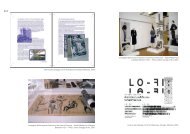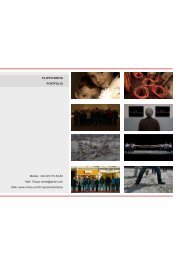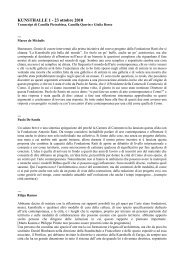Information Sheet Nikolaus Hirsch.pdf - Fondazione Antonio Ratti
Information Sheet Nikolaus Hirsch.pdf - Fondazione Antonio Ratti
Information Sheet Nikolaus Hirsch.pdf - Fondazione Antonio Ratti
You also want an ePaper? Increase the reach of your titles
YUMPU automatically turns print PDFs into web optimized ePapers that Google loves.
Selected projects and exhibitions curated by <strong>Nikolaus</strong> <strong>Hirsch</strong><br />
<strong>Nikolaus</strong> <strong>Hirsch</strong>, Philipp Misselwitz, Markus Miessen, Matthias Gorlich: Development scenario for a<br />
growing art institution<br />
The time-based, growing art institution emerges from the sequential putting-together of individual<br />
segments. This approach breaks with the assumption that an art institution’s plan – with its exhibition<br />
spaces, offices, storage facilities, restrooms, auditorium, cafe, etc. – forms a coherent entity<br />
that is designed by a single author. Instead it divides the space into autonomous yet related components.<br />
The result is a network of possible paths starting from a beginning and branching out in<br />
a number of different directions. The role models are opened up – and who knows: eventually the<br />
artist might act as architect, the curator as artist, and the architect as curator.<br />
<strong>Nikolaus</strong> <strong>Hirsch</strong><br />
Installation view, Helke Bayrle Portikus Under Construction, 2010. Curated by Daniel<br />
Birnbaum, <strong>Nikolaus</strong> <strong>Hirsch</strong> and Melanie Ohnemus, Portikus, Frankfurt am Main<br />
Installation view, Time/Bank, 2011. Portikus, Frankfurt am Main
Giovedì, 26 gennaio 2012, alle 18<br />
XVII. Marco De Michelis intervista <strong>Nikolaus</strong> <strong>Hirsch</strong><br />
NIKOLAUS HIRSCH<br />
The architect <strong>Nikolaus</strong> <strong>Hirsch</strong> is the Dean of the<br />
Städelschule and the Director of Portikus, in<br />
Frankfurt.<br />
He was a Unit Master at the Architectural Association<br />
in London (2000-2005) as well as visiting<br />
professor at the Institute of Applied Theatre<br />
Studies at Giessen University, Hochschule fur<br />
Gestaltung Karlsruhe and University of Pennsylvania<br />
in Philadelphia (2006).<br />
His work includes the Synagogue in Dresden<br />
(2001), a sound architecture for “Frequencies<br />
Hfz” (2002), Bockenheimer Depot Theatre in collaboration<br />
with choreographer William Forsythe<br />
(2003), music pavillon “Soundchambers“ for<br />
Museu Serralves in Porto (2003), an architectural<br />
structure for Bruno Latour´s exhibition<br />
“Making Things Public” (2005), the Synagogue<br />
and Jewish Museum in Munich (2006) and the<br />
Hinzert Museum and Document Center (2006).<br />
Current projects include an office building in<br />
Tbilisi, an art lab for Raqs Media Collective in<br />
Dehli, the unitednationsplaza art institute in<br />
Berlin and the European Kunsthalle in Cologne.<br />
<strong>Nikolaus</strong> <strong>Hirsch</strong> has curated ErsatzStadt:<br />
Representations of the Urban at Volksbuehne<br />
Berlin. His work was awarded with German Critics<br />
Award 2001, World Architecture Award 2002<br />
and BDA-Prize 2006 and was shown in numerous<br />
exhibitions such as Neue Welt (Frankfurter<br />
Kunstverein, 2001), New German Architecture<br />
(Martin-Gropius-Bau Berlin, Milano, 2003),<br />
Utopia Station at the Venice Biennal 2003, and<br />
Can Buildings Curate (Architectural Association<br />
London / Storefront Gallery, New York, 2005).<br />
Photo: Armin Linke<br />
Selected bibliography<br />
<strong>Nikolaus</strong> <strong>Hirsch</strong>, On Boundaries, Sternberg<br />
Press, New York 2007.<br />
<strong>Nikolaus</strong> <strong>Hirsch</strong>, Philipp Misselwitz, Markus<br />
Miessen, Matthias Görlich (Eds.), Institution<br />
Building Artists, Curators, Achitects in the<br />
Struggle for Instituional Space, Sternberg<br />
Press, New York 2007.<br />
<strong>Nikolaus</strong> <strong>Hirsch</strong>, Shveta Sarda, Cybermohalla<br />
Hub, Sternberg Press, New York 2011.<br />
Wandel Hoefer Lorch, <strong>Nikolaus</strong> <strong>Hirsch</strong>,<br />
Material Time, Buchhandlung Walther Konig<br />
GmbH & Co, Koln 2011.<br />
<strong>Fondazione</strong> <strong>Antonio</strong> <strong>Ratti</strong>, Villa Sucota, Via per Cernobbio, 19, 22100 Como, Italia. www.fondazioneratti.org<br />
As an architect, what is your view on designing a space for an artwork or collaborating with curators?<br />
What do you think are the possibilities of the relation between spatial design and presentation<br />
of artworks?<br />
From my own practice as an architect and curator at the Portikus I can say: there is no recipe. First<br />
of all it is crucial to understand that you do not need an architect for the exhibition of artworks. As<br />
Jan Verwoert and I called it on the occasion of his curatorial project in Sheffield: one option is about<br />
“debriefing the architect”. Depending on the artistic approach and curatorial concept of an exhibition<br />
it can make sense to think about a specific display. This can happen in the way Jens Hoffmann<br />
and Adriano Pedrosa worked with Ryue Nishizawa: a clean distribution of labor between curator,<br />
artists and architect. Despite its strong visibility the architecture of display remains in the domain<br />
of service. Yet, display is not only a question for the architectural discipline but one that more and<br />
more artists see as an integral part of their work. This was obvious in the last Venice Biennial when<br />
artists Song Dong, Monika Sosnowska, Oscar Tuazon, and Franz West created architectural structures<br />
in which the work of other artists could be shown. In this case display is not a mere background<br />
but an artistic intervention in its own right. You can even go further: For the European Kunsthalle,<br />
we developed a strategy of “Institution Building” (so the title of the book I co-authored with Markus<br />
Miessen, Philipp Misselwitz and Matthias Görlich), with artists designing an exquisite-corpse-like<br />
museum, trying to merge the concepts of “exhibition” and “museum”, ultimately dissolving the<br />
difference between served and serving, between container, background, and art object.<br />
(From: Pelin Tan, 12th International Istanbul Biennial, domusweb.it, 5 Oct. 2011)<br />
What is your personal take on the current trend of institutionalizing future production, that is<br />
to say art institutions as places of knowledge production becoming, in the long term, initiators<br />
of actualities and matter. How would you describe the new relation between academies and art<br />
institutions such as galleries and museums?<br />
Undoubtedly, there is a new dynamic between museums and academies. This has to do with a<br />
critical understanding of knowledge production, and in a larger context, with the arts aiming for<br />
socio-political relevance. If you look back to the history of exhibitions in the past 15 years it becomes<br />
obvious that some of the most important shows defined their role as that of an initiator of an<br />
active social project. The aim was to reposition the exhibition as a project that would in some way<br />
be transformative on a social scale – something that, by the way, architecture even unintentionally<br />
always does. Yet, it becomes more and more clear that the problem might be that the exhibition<br />
deals with things on the level of representation and might just not be the right format to aim these<br />
ambitious goals. This limitation explains the recent interest of art institutions, such as museums<br />
and galleries, in academic structures. Museums are trying to legitimize and reinvent themselves by<br />
expanding to new audiences and – always in danger of political instrumentalization – by referring<br />
explicitly to their enlightening mission. On the one hand I am organizing matter; inert matter that<br />
ultimately forms something like an institute. On the other hand, I am part of an academic space. In<br />
a certain way this reflects an approach that understands a work of architecture as both a theoretical<br />
model and a physical space. I am trying to connect what used to be separated parts of my work.<br />
This sounds rather simple, but actually it does create a conflict with the highly specialized discipline<br />
of architecture. To produce a building for an exhibition that actually is not an exhibition, but a school,<br />
inevitably implies an architectural practice that is more than design. The shift from exhibition<br />
to school emphasizes a social situation; a communal condition which changes the way things are<br />
manifested physically in space. The effect on myself was a constant negotiation between different<br />
role models: planner, craftsman, and teacher.<br />
(From: <strong>Nikolaus</strong> <strong>Hirsch</strong>, Markus Miessen, Tirdad Zolghadr, Unitednationsplaza: Building Knowledge,<br />
www.104.fr)


